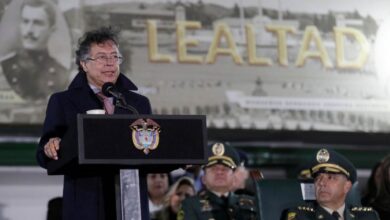Would Ecuador Be Stranded In A Left-wing South America?
Ecuador has gone from having ideologically allied neighbors to being almost "alone". The elections in Brazil and Colombia will be crucial .

Photo: IG-guillermolasso
LatinAmerican Post | Luis Angel Hernández Liborio
Listen to this article
Leer en español: ¿Se quedaría “solo” Ecuador en una Sudamérica de izquierda?
Under Rafael Correa, Ecuador spent a decade oriented to the left that coincided with the governments of Hugo Chávez, Luiz Inácio Lula da Silva, Cristina Fernández, and Evo Morales, among others. With them, Ecuador felt comfortable and its relations were more than friendly, the apparent unity of the region began to crack with the turn to the right of these countries, so it remained isolated until the arrival of Guillermo Lasso to the presidency. Now, the trend is again to the left, so the country seems to be entering a new stage of isolation.
Ecuador, from left to right
Between 2007 and 2017, Ecuador was governed by Rafael Correa, a president who fits in well with the leftist dynamics that the region was experiencing. In his government, the GDP went from 37,219 million euros in 2007 to 92,322 million in 2017, which is why it almost tripled, according to data from Expansión de España. However, Correa's presidency ended amid allegations of corruption and other crimes that buried his political career. His successor and former vice president, Lenin Moreno, opposed Correa and represented a transition that culminated in the arrival of Guillermo Lasso to the government. The current president of Ecuador quickly found allies in Colombia, Brazil, Chile, and Uruguay marking distance with Venezuela in South America and Cuba in the Caribbean, although not with Mexico governed by Andrés Manuel López Obrador. For Ecuador, the situation changes again: Argentina, Chile, Peru, Venezuela, and Mexico are governed by the left in different facets. The presidential elections in Colombia and Brazil this year could end up isolating the country, at least on an ideological level, since at the same time some of these countries are its main partners.
Gustavo Petro in Colombia?
According to the National Consulting Center, Gustavo Petro and Federico Gutiérrez are almost guaranteed to go to the ballot, the first with 36.5% of the voting intention and the second with 24.5%. In the poll for the ballot, the data showed a very close match with Petro barely in the lead with 43.1% compared to 40.1% for Gutiérrez. The Historical Pact candidate is running for his third candidacy trying to emulate what was achieved by López Obrador in Mexico, who also won a victory in his third attempt in a country that, like Colombia, has had a marked tendency to the right. If he wins the presidency, Petro will continue to be a strong critic of Lasso. As soon as Lasso became president-elect, Petro was quick to call his victory a setback for the region, primarily in environmental terms. However, Colombia cannot lose sight of the fact that it is the third country that sells the most to Ecuador, in a trade that represents $1.5 billion dollars, according to the Observatory of Economic Complexity.
Que pasó en Ecuador?
El movimiento indígena logró 1.600.000 votos nulos y le dió el triunfo así, a la extrema derecha extractivista y petrolera.
El progresismo de Arauz no logró introducir en su discurso un proyecto no petrolero y ambientalista
Un retroceso para América Latina
— Gustavo Petro (@petrogustavo) April 12, 2021
You can also read: Colombia: The Presidential Candidates Positions On The ELN And Venezuela
The possible return of Lula da Silva to the presidency of Brazil
In Brazil, Lula da Silva has returned to political life after being imprisoned and the impeachment of Dilma Rousseff that sank his political career. His popularity has improved, the government of Jair Bolsonaro and his position as a political prisoner have him up in the polls. According to the most recent data from the Datafolha Institute, Lula leads the voting intentions with 43% against President Bolsonaro, who is seeking re-election and who has just 26% of the preferences, both are leaders. Despite the size of the Brazilian economy, Ecuador hardly imports $614 million dollars and the South American giant does not even appear among the first five destinations for Ecuadorian exports. The understanding of Jair Bolsonaro and Lula's leftist position could define the relations between the two countries in the future, which beyond being cordial will not deepen the economic exchange between the two countries.
Where should Ecuador lean?
If the arrival of Lula and Petro in Brazil and Colombia, respectively, is completed, Ecuador would be left "alone" in South America and the region in general. But beyond the differences in politics, the weight of trade could be decisive in maintaining good relations. Chile is one of its most important export destinations with $823 million dollars in 2020, in addition to Colombia, Peru and Brazil from which it imports $2.7 billion dollars together. Argentina and Venezuela are not among its main partners, relations with Maduro will hardly come to fruition. Finally, Ecuador became an Associated State of the Pacific Alliance in 2019 and in January of this year it requested formal admission as a full member , so its relationship with Colombia, Peru, Chile and Mexico (these last three already with governments of left) is crucial to Lasso's economic aspirations and his intention to position Ecuador in the global context. In matters of foreign policy, the Uruguay of Luis Lacalle Pou and the Paraguay of Mario Abdo Benítez will be his only possible allies in the region. This shows that they must find common ground with the more moderate governments and thus not be excluded.





